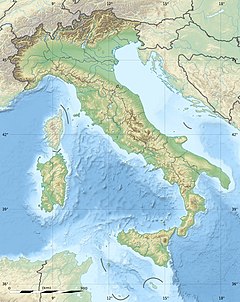Risiera di San Sabba
| Risiera di San Sabba | |
|---|---|
| Concentration camp | |
 Internal courtyard of the Risiera di San Sabba. The remains of the crematorium can be seen on the wall. | |
| Coordinates | 45°37′15″N 13°47′21″E / 45.62083°N 13.78917°E |
| Location | Trieste, Italian Social Republic |
| Operated by | SS |
| Inmates | Italian Political prisoners, Italian Jews, Yugoslavian Resistance fighters and Yugoslavian civilians (primarily Slovenes and Croats) |
| Killed | 3,000–5,000 |
| Notable inmates | Boris Pahor |
Risiera di San Sabba (Slovene: Rižarna) is a five-storey brick-built compound located in Trieste, northern Italy, that functioned during World War II as a Nazi concentration camp for the detention and killing of political prisoners, and a transit camp for Jews, most of whom were then deported to Auschwitz.[1]
The cremation facilities, the only ones built inside a concentration camp in Italy, were installed by Erwin Lambert, and were destroyed before the camp was liberated. Today, the former concentration camp operates as a civic museum.[2]
Background
The building was erected in 1913 and first used as a rice-husking facility (hence the name Risiera). During World War II, German occupation forces in Trieste used the building to transport, detain and exterminate prisoners. Many occupants of Risiera di San Sabba were transported to the German Nazi concentration camp at Auschwitz-Birkenau in Occupied Poland.[3] Historians[who?] estimate that over 3,000 people were killed at the Risiera camp and thousands more imprisoned and transported elsewhere. The majority of prisoners came from Friuli, the Julian March and the Province of Ljubljana.[citation needed]
Boris Pahor was also held at the camp before being transported to the concentration camps of Dachau and Natzweiler-Struthof.[citation needed]
After the war, the camp served as a refugee camp and transit point for the mass exodus of soldiers of the Royal Yugoslav Army and their families who were loyal to King Peter II and the 1950s for many people, especially ethnic Italians fleeing former Italian territory in the Socialist Federal Republic of Yugoslavia.[4][5][6]
See also
References
- ^ La Risiera di San Sabba. Le Deportazioni, La Liberazione. moked/מוקד il portale dell'ebraismo italiano.
- ^ The Museum (2009). "Risiera di San Sabba. History and Museum" (PDF). International Committee of the Nazi Lager of Risiera di San Sabba, Trieste. pp. 1–7. Archived from the original (PDF) on September 7, 2012. Retrieved 1 May 2015.
- ^ The Museum (2009). "Risiera di San Sabba. History and Museum" (PDF). With Selected Bibliography. International Committee of the Nazi Lager of Risiera di San Sabba, Trieste: 1–7. Archived from the original (PDF) on September 7, 2012. Retrieved 1 May 2015.
- ^ Floreak, Michael (January 20, 2016). "Italian Cooking Master Shares Stories, Recipes". The Boston Globe. Boston, MA. p. G9. Retrieved April 1, 2023 – via Newspapers.com.

- ^ Pamela Ballinger (1999). "The Politics of the Past: Redefining Insecurity along the 'World's Most Open Border'". In Weldes, Jutta; Laffey, Mark; Gusterson, Hugh; Duvall, Raymond (eds.). Cultures of Insecurity: States, Communities, and the Production of Danger. Minneapolis: University of Minnesota Press. p. 83.
- ^ John Foot (2013). "Memories of an Exodus: Istria, Fiume, Dalmatia, Trieste, Italy, 1943–2010". In Baratieri, Daniela; Edele, Mark; Finaldi, Giuseppe (eds.). Totalitarian Dictatorship: New Histories. New York: Routledge. p. 242.
External links
- Risiera di San Sabba Official website (in Italian)
- Risiera di San Sabba Museum (in Italian) with link to a downloadable English PDF file
- 27 gennaio 2010 "Giorno della Memoria" a Trieste presso la Scuola Agenti di Polizia, Carcere Coroneo e Risiera di San Sabba


